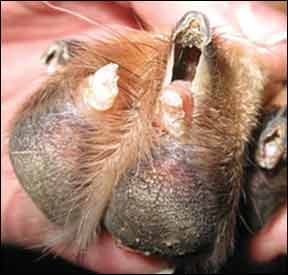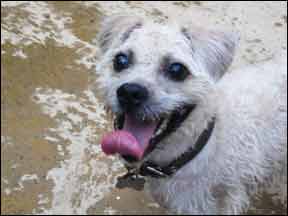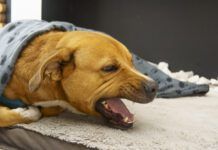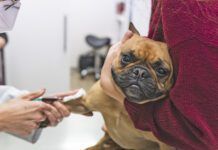Dog nails aren’t supposed to fall off, thought first-time dog owner Terrie Huberman some 18 months ago. That’s when she first realized that finding one of her Pug-Poodle mix’s nails on the floor of her Sherman Oaks, California, apartment wasn’t an isolated incident.

It all started when, after coming in from a walk, Terrie picked up what would turn out to be the keratin shell from one of Bonzo’s claws. At the time she thought it was something he’d tracked in from outside. Only later did she learn the shell was a telltale sign of Symmetrical Lupoid Onychodystrophy, SLO for short.
SLO is an inflammation of the nail matrix where the nail is formed. The pattern of inflammation is similar to lupus, giving the condition its “lupoid” designation. The inflammatory reaction at the nail matrix results in abnormal nail development and growth, resulting in compromised claws that lift, separate, and often fall off. Flare-ups are painful and many owners first notice a problem when the dog begins favoring or nursing an affected foot.
While SLO can affect all breeds of dogs, some vets report seeing far more cases among certain breeds. “When I think of SLO, I think of German Shepherds, Miniature Schnauzers, Rottweilers, and Corgis,” says holistic veterinary practitioner Frank Bousaid, DVM, of Harmony Animal Wellness Center in Monroe, Washington. “In the German Shepherd, it seems to be worse, with more toes involved, in males than females.” His experience supports further anecdotal evidence found online, which cites German Shepherd Dogs as being predisposed to the condition.
A dog’s claw is made up of three distinct layers. The visible outer portion that must be routinely trimmed is hard, dead material. The innermost layer – the “quick” – is comprised of nerves and the blood supply; this is what bleeds when the nail is trimmed too short. Initial nail growth occurs at the root, located deep in the toe. In dogs with SLO, damage takes place at the root level about three to four months before the nail becomes visible. When affected nails emerge, they are misshapen and can also be hollow, soft or brittle, or discolored.
Onset is typically acute, with one or two claws initially being affected. “One of the hallmarks of SLO is multiple claw lesions,” says Alexander Werner, VMD, Diplomate of the American College of Dermatology. “If I had a case that came in with a single digit where the claw was abnormal, Lupoid Onychodystrophy would not be high on my list. SLO by definition affects multiple nails.”
Both vets agree the condition is relatively rare. As a veterinary dermatologist, Dr. Werner estimates he treats fewer than 10 patients per year.
Diagnosis
Achieving a definitive diagnosis can be tricky because it requires a biopsy of the nail matrix, which must be accomplished by removing a piece of the third phalanx – the last part of the toe. This surgical procedure, much like a de-clawing of a cat, has a painful recovery and results in a malformation of any nail growth that follows (since the nail matrix has been surgically altered). For owners looking for an absolute diagnosis, dogs with affected dew claws are considered the best candidates for biopsy.
Due to the highly invasive nature of the biopsy, vets often make an initial diagnosis based on the characteristics of the disease, or, because treatment is well tolerated by most dogs, many vets will begin treatment on the suspicion of SLO, watching for signs of improvement.
Treatment
Both traditional and holistic practitioners agree on the core treatment protocol for SLO. High-dose essential fatty acids (EFAs), specifically omega-3 and omega-6, along with a generally well-tolerated antibiotic such as tetracycline or doxycycline is the most common approach. Antibiotics are used to try to save affected nails while preventing nail bed infections, which can get into the bone and lead to the loss of the toe. Nail bed infections also affect circulation to the feet. EFAs are used for their anti-inflammatory properties.

“In SLO, there is an unexplained inflammatory process that is happening at the cuticle level,” explains Dr. Bousaid. “There’s an infiltrate of inflammatory cells into the nail bed. That’s the immune-mediated part; this huge attack by the immune system on the nail bed. Omega-3s and omega-6s act as an anti-inflammatory to help calm down the overactivity.”
When it comes to EFAs, Dr. Bousaid strongly recommends salmon oil dispensed in free-fluid form rather than processed and encapsulated for convenience. “I like salmon oil specifically; I think it’s the gold standard of fish oils in dogs,” he says, noting that salmon oil has an ideal ratio of omega-3 to omega-6 for dogs. He recommends clients stay away from cod liver oil , which is frequently manufactured in China and can be months or years old by the time it’s purchased and consumed in the U.S. He does not recommend the use of flaxseed oil, which is often popular with vegetarian clients looking to avoid animal products. He cautions that Omega-3s and omega-6s from non-animal sources such as flaxseed oil are poorly utilized by dogs.
In addition to antibiotics and high-dose fatty acids, Dr. Bousaid also incorporates vitamin B (specifically niacinamide, not niacin or nicotinic acid), vitamin E, and plain gelatin.
“Vitamin B serves as a natural free radical scavenger for anything that’s collagen based – skin, nails, etc.,” he says. “It has to do with the development of the dermal layer and aids in the foundational structure of the nail. I use vitamin B for its nail-strengthening properties. It aids in the development of the nail matrix that will harden and become part of the nail. Vitamin E also helps the nail matrix, playing a role in healthy nail formation.” It’s believed that the fatty acids and vitamins work in tandem. Fatty acids help reduce inflammation and vitamins B and E serve as tools to help rebuild the nail.
Long-Term Challenge
One challenge with treatment is that much of the disease activity takes place before nail growth is even visible. Additionally, the disease is often cyclical, so many vets opt for lengthy treatment plans.

“I usually follow a treatment protocol of four to eight weeks,” says Dr. Werner. “The four weeks is just to make sure things are going well and to see that we’re starting to get some good re-growth of lost nails and no additional nail loss. At eight weeks we’ll get a sense of how well the nails are doing. This disease can wax and wane and I want to make sure we’re not in a waning phase before I withdraw a drug that might be helpful. Because the therapy is so well tolerated, inexpensive, and benign for long-term use, I usually go six months before thinking of changing the therapy.”
Many vets, especially those who rarely encounter cases of SLO, will prescribe a steroid such as prednisone in an attempt to reduce inflammation. Both Dr. Werner and Dr. Bousaid consider this ill-advised, noting the host of secondary problems that can arise from steroid use.
“In situations where a vet has prescribed steroids to treat suspected or confirmed SLO, a referral to an animal dermatologist is very important,” says Dr. Werner. “One of the reasons people see dermatologists is to get dogs off steroids for skin conditions. I think steroids are overkill; you may produce a lot of systemic problems by using a potent medication that may or may not be necessary. I think it’s pulling out a big gun when you need a sharp shooter.” Steroid use can result in increased thirst, appetite, weight gain, and muscle loss, and can have negative effects on the liver.
“In extreme cases, short-term steroid use may be needed, but given a choice, it’s best to use something else,” cautions Dr. Werner.
Prognosis
While not curable, most dogs tolerate treatment well and once it stimulates new nail growth, antibiotics can often be eliminated from a maintenance regimen of EFAs and vitamins. when flare-ups occur, booties or restricted activity are recommended to help protect the affected claws. Many patients report success with bathing the feet in a saline or diluted antiseptic solution after walks.
“I don’t think it’s curable, but it’s controllable and most dogs do very well,” says Dr. Werner.
Such is the case with Bonzo. One year into treatment, the veterinarian successfully dropped antibiotics from Bonzo’s treatment plan; Terrie continues to give Bonzo EFAs and vitamin E daily. An energetic bundle of youthful energy, his quality of life remains unaffected, except for occasional flare-ups, which fortunately are nowhere near as involved as the initial presentation of the disease.
“His nails are looking much better,” she says. “The SLO is totally manageable now. When he has a flare-up, mostly in the summer, we avoid going hiking. I feel like it has stabilized, and I’m not nearly as panicked about it.”






Just to let you all know, I had a German Shepherd that sufford from this, so I did my research and started talking to a husky owner from Alaska, he told me his story, he said his Siberion huskys had stated losing nails, so he treated his dogs nails with anticeptic powders but this stopped infection but not the slo in the nail, so one day they ran out of the usual food that was fed to the dog’s, so he bought a drum of fish heads from the local fishery, after 3 or for weeks he noticed a massive improvement in the nails, and kept feeding the fish heads to the dog with the nail problem about a month later the old nails had gone and new nails had grown, the dog never suffered again after that but was kept on the fish diat, in conclusion he thought almost 💯 that the change in diet to oily fish heads is what cured the problem, you know what he was right.
My dog also had exactly the same, so I did the same thing as the guy from Alaska and started adding oily fish to my dogs diet every day a can of sardines in their own oil kept treating the nails with antiseptic powders for 4 weeks and then all of my dogs nails fell out, 2wks later they started growing back, this to me was amazing, something in the oily fish was working, my dog put on weight and was healthy again, to this day he gets oily fish in with his dry food and his nails are perfect 2 yrs on, it turns out that the lack in vitamins in certain dog’s causes this problem especially lack of omega 3 in the liver, this made sense to me and cured my dog 💯 and the affliction has never returned and my dog is beautiful and healthy.
Wow, I have 5 German Shepherds but one of them, an 8 year old female has had this problem for Years!!! She has chewed on her nails since she was young but because she has an extremely high drive, every vet has always blamed the chewing on her high drive. Her dew claws look like Lobster Claws, her nails used to be black but she constantly breaks them or rips them off and her front nails are now white or clear. They are impossible to trim due to splitting or breaking and it causes her pain but even though she is trained, she fights the dremel.
I am SO glad I stumbled upon this information. I get Whole Dog Journal but somehow I missed this and so did the three different Veterinarians she has seen.
We will get on this right away because this girl has worked hard for me and she deserves nothing less.
Thank You
Sandy Robinson, I wanted to check in to see if you could update us on your 8 year old female German Shepherd. We have an English Lab that has done the exact same thing (chewing on nails especially dew claw) he is 7.